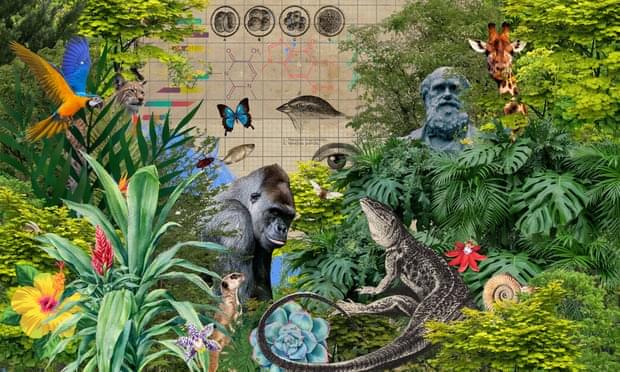Archive for the ‘evolution’ category: Page 31
Dec 30, 2023
17 Marta Halina — Resource constraints and the evolution of cognition
Posted by Dan Breeden in categories: biological, evolution, neuroscience

UCLA department of integrative biology and physiologyluskin endowment for leadership symposiumpushing the boundaries: neuroscience, cognition, and lifemarta…
Dec 30, 2023
Scientists Propose New Explanation for “Impossible” Gamma-Ray Burst
Posted by Saúl Morales Rodriguéz in categories: cosmology, evolution, physics

In 2022, scientists from Northwestern University presented novel observational data indicating that long gamma-ray bursts (GRBs) might originate from the collision of a neutron star with another dense celestial body, such as another neutron star or a black hole — a finding that was previously believed to be impossible.
Now, another Northwestern team offers a potential explanation for what generated the unprecedented and incredibly luminous burst of light.
Continue reading “Scientists Propose New Explanation for ‘Impossible’ Gamma-Ray Burst” »
Dec 30, 2023
What Will Humans Look Like in 1 Million Years?
Posted by Shubham Ghosh Roy in categories: evolution, futurism

Go to https://sponsr.is/cs_whatif and use code WHATIFSHOW to save 25% off today. Thanks to Curiosity Stream for sponsoring today’s video.
One thousand years into the future, humans might look like this.
Continue reading “What Will Humans Look Like in 1 Million Years?” »
Dec 29, 2023
Michael Levin | Evolution, Basal Cognition and Regenerative Medicine
Posted by Dan Breeden in categories: biotech/medical, evolution, life extension

Talk kindly contributed by Michael Levin in SEMF’s 2023 Interdisciplinary Summer School: https://semf.org.es/school2023/sessions.html#S1TALK ABSTRACTEach of u…
Dec 26, 2023
Do we need a new theory of evolution?
Posted by Shubham Ghosh Roy in categories: biological, evolution
A new wave of scientists argues that mainstream evolutionary theory needs an urgent overhaul. Their opponents have dismissed them as misguided careerists – and the conflict may determine the future of biology.
Dec 26, 2023
Social learning: Simulation model shows how groups can keep important information within and across generations
Posted by Dan Breeden in category: evolution
One of the most actively debated questions about human and nonhuman culture is this: Under what circumstances might we expect culture, in particular the ability to learn from one another, to be favored by natural selection?
Researchers at the Max Planck Institute for Evolutionary Anthropology in Leipzig, Germany, have developed a simulation model of the evolution of social learning. They showed that the interplay between learning, memory and forgetting broadens the conditions under which we expect to see social learning to evolve.
Social learning is typically thought to be most beneficial when the environments in which individuals live change quite slowly—they can safely learn tried and tested information from one another and it does not go out of date quickly. Innovating brand-new information, on the other hand, is thought to be useful in dynamic and rapidly changing environments.
Dec 25, 2023
Ancient Neanderthal DNA Shaping Modern Morning Habits
Posted by Saúl Morales Rodriguéz in categories: biotech/medical, evolution, genetics
A new paper in the journal Genome Biology and Evolution, published by Oxford University Press, finds that genetic material from Neanderthal ancestors may have contributed to the propensity of some people today to be “early risers,” the sort of people who are more comfortable getting up and going to bed earlier.
Human Evolution and Genetic Adaptation
All anatomically modern humans trace their origin to Africa around 300 thousand years ago, where environmental factors shaped many of their biological features. Approximately seventy thousand years ago, the ancestors of modern Eurasian humans began to migrate out to Eurasia, where they encountered diverse new environments, including higher latitudes with greater seasonal variation in daylight and temperature.
Dec 25, 2023
Psychedelic concentrations of nitrous oxide reduce functional differentiation in frontoparietal and somatomotor cortical networks
Posted by Dan Breeden in categories: biotech/medical, evolution, neuroscience
Cortical gradient mapping stands as an innovative analytical tool for exploring the brain’s functional-spatial organization along a continuous spectrum28,29,30, distinguishing it from conventional techniques reliant on discrete boundaries, e.g., functional parcellation in neuroimaging. As an intuitive metaphor, consider defining a geographic region by its boundary coordinates, which is akin to functional parcellation, versus describing it by elevation slopes or changes in vegetation types across various topographical axes, which is similar to gradient mapping. These cortical gradients span a wide spectrum of functions and networks, ranging from perception and action to higher-order cognitive processes28. Notably, Gradient-1, known as the unimodal to transmodal gradient, enables the integration of sensory signals with non-sensory data, transforming them into abstract content. Gradient-2, the visual to somatomotor gradient, represents the specialization of different sensory modalities. Lastly, Gradient-3 spans functional distinctions ranging from regions typically deactivated during task performance (i.e., task-negative) to those activated in frontoparietal and attention networks (i.e., task-positive)31,32. Despite promising foundations, the potential of gradients as a framework for analyzing and conceptualizing non-ordinary states of consciousness induced by psychedelics remains ripe for exploration.
In addition to the brain’s functional geometry, dynamic processes continuously mold and reconfigure functional arrangements, leading to the evolution of brain activity patterns over time33,34. Recent empirical investigations have highlighted the intricate interplay between the spatial and temporal characteristics of brain activity, emphasizing that a comprehensive understanding necessitates the consideration of both aspects. Notably, transient fMRI co-activations33,35,36 spanning the entire cortex have been observed to propagate like waves, following the spatially defined cortical gradients37,38,39. Consequently, temporal dynamics are likely to be influenced by the underlying functional geometry. Exploring the co-variation between these spatial and temporal factors holds the potential to offer deeper insights into the neural underpinnings of psychedelic effects.
The objective of this study was to apply advanced cortical gradient mapping and co-activation pattern analysis to dissect the brain’s spatiotemporal reconfiguration during the psychedelic experience induced by nitrous oxide. Building upon previous research findings16,25, we tested the hypothesis that nitrous oxide could diminish functional differentiation within the human cortex, as evidenced by a contraction in functional geometry and a disruption in temporal dynamics. We reanalyzed a neuroimaging dataset of healthy human volunteers, who were assessed by fMRI before and during exposure to psychedelic concentrations of nitrous oxide (35%, in oxygen) and who completed a validated altered states of consciousness questionnaire40 before and after drug exposure. We quantified the changes of neural activity in cortical gradients and co-activations; we also performed correlation analyses to explore the relationship between subjective psychedelic experience and these brain measures. We demonstrate that nitrous oxide flattens the functional geometry of the cortex and disrupts related temporal dynamics, particularly within the frontoparietal and somatomotor networks, in association with the psychedelic experience.
Dec 24, 2023
Researchers develop effective method to genetically modify brain organoids
Posted by Dan Breeden in categories: biotech/medical, evolution, genetics, neuroscience
Primates are among the most intelligent creatures with distinct cognitive abilities. Their brains are relatively large in relation to their body stature and have a complex structure. However, how the brain has developed over the course of evolution and which genes are responsible for the high cognitive abilities is still largely unclear. The better our understanding of the role of genes in brain development, the more likely it will be that we will be able to develop treatments for serious brain diseases.
Researchers are approaching these questions by knocking out or activating individual genes and thus drawing conclusions about their role in brain development. To avoid animal experiments as far as possible, brain organoids are used as an alternative. These three-dimensional cell structures, which are only a few millimeters in size, reflect different stages of brain development and can be genetically modified. However, such modifications are usually very complex, lengthy and costly.
Researchers at the German Primate Center (DPZ)—Leibniz Institute for Primate Research in Göttingen have now succeeded in genetically manipulating brain organoids quickly and effectively. The procedure requires only a few days instead of the usual several months and can be used for organoids of different primate species. The brain organoids thus enable comparative studies of the function of genes at early stages of brain development in primates and help to better understand neurological diseases.














